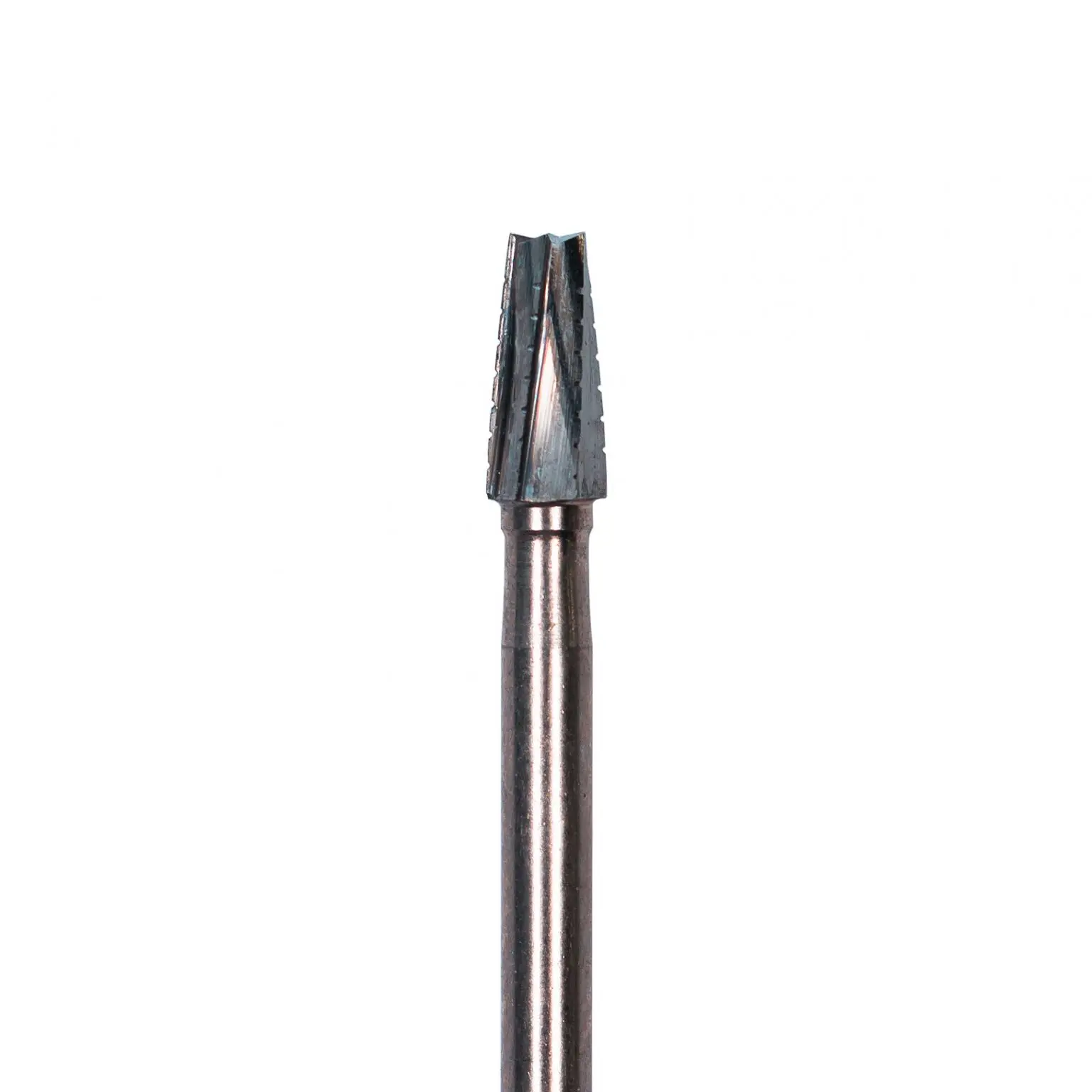cutting burs are essential tools used in various industries, particularly in dentistry and orthopedics. Understanding the materials used to manufacture these tools is crucial for professionals who rely on their efficiency and durability. This article delves into the different materials used to make cutting burs, examining their properties, applications, and the industries they benefit the most. Whether sourced from a cutting burs manufacturer, a cutting burs factory, or a cutting burs supplier, the choice of material plays a pivotal role in the performance and longevity of these vital instruments.
Introduction to Cutting Burs
● Definition and Purpose of Cutting Burs
Cutting burs are rotary instruments designed for precise cutting, grinding, and shaping of hard tissues such as tooth enamel or bone. They are indispensable in fields like dentistry, where they are used for cavity preparation, tooth reduction, and restorative work. These tools are also employed in orthopedics for bone drilling and shaping during surgeries. The effectiveness of cutting burs heavily depends on the material from which they are made, as it affects their cutting ability, speed, and durability.
● Overview of Industries that Use Cutting Burs
Apart from dentistry and orthopedics, cutting burs are utilized in industries such as jewelry-making, model engineering, and craft work. Each industry may prioritize different characteristics in cutting burs, such as the sharpness for intricate designs in jewelry or durability in orthopedic applications. Wholesale cutting burs are often sourced for these diverse applications, ensuring that different sectors have access to the specific types needed for their tasks.
Types of Cutting Burs
● Categorization Based on Application
Cutting burs can be categorized based on their intended applications: dental, surgical, laboratory, and industrial. Each category has specific requirements in terms of material hardness, flexibility, and resistance to wear. Dental burs, for example, require materials that can efficiently cut through enamel and dentin, while surgical burs need materials capable of handling bone and other tissues without degrading quickly.
● Common Shapes and Sizes
Burs come in a variety of shapes and sizes, including round, pear-shaped, cylindrical, flame, and inverted cone. The shape of the cutting bur determines its specific use; for instance, round burs are typically used for caries removal, while cylindrical burs are preferred for smoothing and finishing surfaces. The size of the bur affects its precision and speed; smaller burs offer more control and detail, while larger burs can remove material more quickly.
Material Properties and Importance
● Why Material Choice Matters
The choice of material for cutting burs is crucial as it affects the tool's performance, lifespan, and efficiency. Materials determine the bur’s resistance to wear and corrosion, its ability to withstand sterilization processes, and its compatibility with different tissues or materials. Selecting the appropriate material can significantly enhance clinical outcomes and reduce the need for frequent replacements.
● Impact on Performance and Durability
Materials directly influence the cutting speed and precision of burs. Harder materials like tungsten carbide and diamond offer superior cutting ability and longer lifespan, making them ideal for high-speed applications. Conversely, softer materials might provide more flexibility but wear out faster, requiring more frequent replacement. The balance between hardness and flexibility is an essential consideration for manufacturers and suppliers.
High-Speed Steel (HSS) Burs
● Characteristics and Applications
High-speed steel (HSS) is a traditional material used in cutting burs due to its toughness and resistance to high temperatures. HSS burs are particularly favored in applications where cost-effectiveness is a priority, and they are often used in laboratory settings and for the initial phases of dental procedures. They offer a balance of hardness and toughness, which makes them suitable for various applications.
● Advantages and Disadvantages
The primary advantage of HSS burs is their affordability and ability to withstand reasonable amounts of heat without losing temper. However, they do not maintain their sharpness as well as harder materials like carbide or diamond, leading to more frequent replacements. HSS burs are ideal for low-speed applications where precision is less critical.
Tungsten Carbide Burs
● Properties That Make Carbide Popular
Tungsten carbide is renowned for its exceptional hardness and resistance to wear, making it a popular choice for cutting burs. It allows for precise, smooth cutting with minimal vibration, which is crucial for patient comfort and procedural efficiency in dentistry and surgery. This material maintains its edge longer than HSS, reducing the frequency of replacements.
● Typical Use Cases and Benefits
Tungsten carbide burs are commonly used in dentistry for cavity preparation, crown removal, and cutting through metal restorations. They are also employed in orthopedic surgeries for bone shaping and cutting. The durability and sharpness of carbide burs make them highly effective for both high-speed and low-speed applications, providing versatility across different procedures.
Diamond Coated Burs
● Unique Features of Diamond Coating
Diamond-coated burs are widely recognized for their superior cutting precision and smooth finishes. The diamond particles embedded in the bur's surface offer exceptional hardness, enabling them to cut through the toughest materials like enamel, porcelain, and even metal. This makes them invaluable in dental procedures that require high accuracy and minimal material removal.
● Ideal Scenarios for Using Diamond Burs
Diamond burs are ideal for procedures that require meticulous attention to detail, such as cosmetic dentistry and complex restorative work. They are also used in surgical settings where precision cuts are required. Despite their higher cost, the precision and finish they offer justify their use in specialized applications.
Ceramic Burs: An Emerging Choice
● Advantages of Ceramic Over Traditional Materials
Ceramic burs have emerged as an innovative alternative to traditional materials, offering benefits such as reduced heat generation and minimal clogging. They provide a more gentle cutting experience, which can be advantageous for procedures requiring minimal thermal damage. Ceramic burs are also resistant to corrosion, making them durable options for various applications.
● Potential Applications and Limitations
Ceramic burs are particularly suitable for soft tissue work and delicate procedures where heat generation must be minimized. However, they may not have the same cutting strength as carbide or diamond burs and are typically used in tandem with other materials depending on the procedural requirements. Their fragility also limits their use in high-impact applications.
Comparing Metal and Non-Metal Burs
● Key Differences in Usage and Longevity
Metal burs, including those made from HSS and tungsten carbide, provide sturdy cutting options with excellent longevity and are suited for a broad range of applications. In contrast, non-metal burs such as ceramic and diamond-coated burs offer unique advantages in precision and reduced thermal damage but may have limitations in durability under certain conditions.
● Pros and Cons of Metal Versus Non-Metal
The choice between metal and non-metal burs depends on the specific needs of the procedure. Metal burs offer robustness and are generally more affordable, while non-metal burs excel in precision and surface finish. Each type has its own set of advantages and limitations, influencing their application in different industries and usage scenarios.
Innovations in Cutting Bur Materials
● Recent Advances and Research Trends
Recent innovations in cutting burs focus on enhancing material properties to improve performance and efficiency. Hybrid materials that combine the strength of metal with the precision of non-metal substances are being explored to offer the best of both worlds. Advancements in manufacturing technologies, such as 3D printing and nanotechnology, are also contributing to the development of cutting burs with superior characteristics.
● Future Potential and Industry Impact
The future of cutting bur materials looks promising, with ongoing research likely to yield more durable, efficient, and versatile tools. These innovations will further enhance procedural outcomes in dentistry, orthopedics, and beyond, providing professionals with better tools to meet the evolving demands of their fields. Wholesale cutting burs will continue to evolve with these advancements, offering a broader range of options for manufacturers and suppliers to provide to the market.
Choosing the Right Bur Material
● Factors to Consider When Selecting Materials
When selecting the material for cutting burs, factors such as the specific application, desired cutting speed, and budget considerations must be taken into account. The material's resistance to wear, compatibility with sterilization processes, and ability to provide a smooth finish are crucial elements that influence decision-making for manufacturers, suppliers, and end-users.
● Matching Material Properties to Specific Needs
Matching the material properties of cutting burs to the specific needs of a procedure ensures optimal performance and outcomes. For instance, high-speed applications benefit from tungsten carbide, while procedures requiring precision and fine detail might prefer diamond-coated options. Understanding these nuances helps in choosing the right cutting burs for each unique application.
Conclusion
Selecting the appropriate material for cutting burs is essential in ensuring their efficiency, durability, and overall performance. Whether sourced from a cutting burs manufacturer, a cutting burs factory, or a cutting burs supplier, understanding the strengths and limitations of materials like HSS, tungsten carbide, diamond, and ceramics allows professionals to make informed choices tailored to their specific needs. As technologies advance, the industry will continue to see improvements in cutting burs, providing ever-better tools for the varied demands of dental, surgical, and industrial applications.
● About Boyue
Jiaxing Boyue Medical Equipment Co., Ltd is a leading manufacturer renowned for mastering 5-axis CNC precision grinding technology. Specializing in medical rotary cutting tools, Boyue offers a comprehensive range of products including dental burs, dental files, bone drills, and orthopedic surgical tools. With a strong R&D team, precise inspection, and large production capacity, Boyue delivers outstanding quality and competitive pricing. Boyue's commitment to quality is evident through its continuous improvement processes, making it a distinguished supplier for global markets over 23 years.

Post time: 2024-11-07 15:18:02


